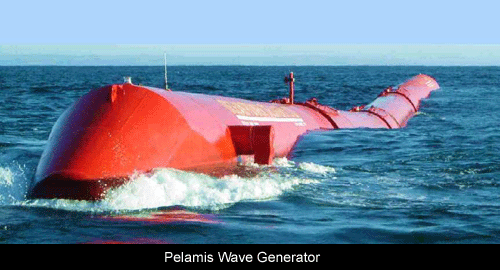Wave power refers to the energy of the ocean surface and the capture of that energy to generate electricity. It can also be used to power desalination plants, or pump water into reservoirs. This is certainly a form of renewable energy, and although often co-mingled, it is distinct from the flux of tidal power and ocean currents.
These energy conversion devices create a system of reacting forces, in which two or more bodies move relative to each other, while at least one body interacts with the waves. The body moved is called the displacer, while the body that reacts to the displacer is called the reactor.
There are many ways that such a system may be configured, including: oscillating water columns, point-absorbers, attenuators, and over topping devices. There is even biomimicry technology that looks to nature for inspiration.
This type of power generation is not a widely employed technology, with only a few experimental sites in existence. The market potential for hydrokinetic energy is vast, ranging from small-scale distributed generation applications to large-scale power plants.

In general, large breakers are more powerful. Specifically, power is determined by height, speed, wavelength, and water density. The size is determined by wind speed and fetch (the distance over which the wind excites the water) and by the depth and topography of the seafloor (which can focus or disperse the energy). A given wind speed has a matching practical limit over which time or distance will not produce larger waves. This limit is called a “fully developed sea.”
This power source could yield much more energy than tidal power. Tidal dissipation (friction, measured by the slowing of the lunar orbit) is 2.5 terawatts. The energy potential is certainly greater, and the power of the sea in this form could be exploited in many more locations. Countries with large coastlines and strong prevailing winds (notably, Ireland and the UK) could produce five percent or more of their electricity from this source of power. Excess capacity (a problem common with intermittent energy sources) could be used to produce hydrogen or smelt aluminum.
A floating buoy, submerged system or an offshore platform placed many kilometers from land is not likely to have much visual impact. Onshore facilities and offshore platforms in shallow water could, however, change the visual landscape from one of natural scenery to industrial. These are considerations, but ultimately we need to balance the need for sustainable energy against visual impact. Which would you choose between?
During September 2008 the Pelamis technology pictured above became the world’s first commercial sea power plant converting waves into electricity. Situated off Portugal’s coast the project is expected to expand nearly 10-fold in the coming years.
Generating a total of 2.25 megawatts, the power is enough to supply 1,500 households the project cost is reported to be around 8.5 million Euros (US$12.55 million).
Although the price is not currently competitive, the project was possible due to the feed-in tariff in Portugal.
